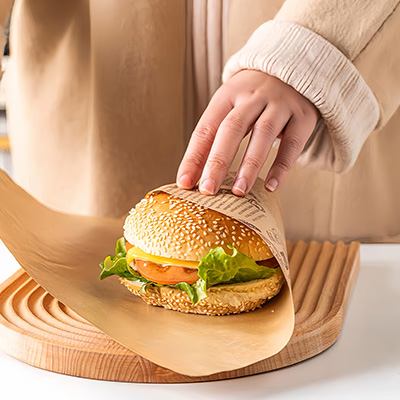
Le papier hamburger résistant à l'huile est un type spécial de papier conçu pour résister à la graisse et à l'humidité et est généralement utilisé pour emballer et servir des hamburgers et d'autres aliments gras. En plus d'être principalement utilisé pour emballer des hamburgers, le papier hamburger résistant à l'huile a également une large gamme d'applications dans divers scénarios de cuisine et de restauration. Sa résistance à la graisse et à l'humidité le rend adapté à de nombreuses utilisations dans l'industrie alimentaire.
1. Sandwichs et Packaging: Le papier hamburger résistant à l'huile peut être utilisé pour emballer des sandwichs, des burritos et des sandwichs. Sa capacité à empêcher la graisse et l'humidité de s'infiltrer dans le papier aide à maintenir l'intégrité du pain et d'autres ingrédients, assurant une expérience alimentaire sans confusion.
2. Aliments frits: Les propriétés résistantes à la graisse de ce papier en font un excellent choix pour les aliments frits tels que les frites, les rondelles d'oignon et le filet de poulet. Mettre ces choses sur du papier résistant à l'huile peut aider à absorber l'excès d'huile et empêcher les aliments de devenir humides.
3. Produits de boulangerie: Le papier hamburger résistant à l'huile peut être utilisé pour les présentations de boulangerie ou pour l'emballage d'articles tels que des biscuits, des pâtisseries et des muffins. Il garantit que les produits de boulangerie restent frais et visuellement attrayants sans laisser de taches d'huile disgracieuses.
4. Food trucks et plats à emporter: Le papier hamburger résistant à l'huile est souvent utilisé dans les food trucks et les plats à emporter pour emballer toutes sortes de plats chauds. Sa capacité à maintenir la qualité et l'apparence des aliments pendant le transport est précieuse pour assurer la satisfaction du client.
5. Activités extérieures: Qu'il s'agisse d'un pique - nique, d'un barbecue ou d'une activité de plein air, l'utilisation de papier résistant à l'huile pour contenir une variété d'aliments peut aider à garder les mains et les surfaces propres. Sa résistance à l'humidité et à la graisse le rend idéal pour les repas en plein air.
Essentiellement, la polyvalence du papier hamburger résistant à l'huile ne se limite pas aux hamburgers emballés. Ses propriétés de résistance aux graisses en font un outil précieux pour servir une variété d'aliments chauds, gras ou humides dans divers environnements de restauration, contribuant ainsi à améliorer la qualité des aliments et la satisfaction du client.